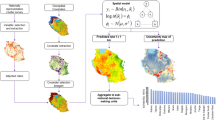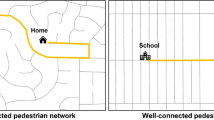Abstract
For the effective implementation of social support facilities or infrastructures, knowledge of the physical and sociodemographic characteristics of the catchment area is required. However, it is precisely the definition and profiling of this catchment area that causes the main problems.
This paper raises the question of the Modifiable Areal Unit Problem (MAUP) and presents a method for catchment area profiling that takes account of socioeconomic and contextual attributes. Facility catchment areas are defined by a function that takes account of context indicators, enabling a broader yet more precise (and therefore more thorough) profiling of the area.
As a case study in the application of this method, this paper describes the existing supply of pre-school facilities in the municipality of Amadora and analyses the area's needs with regards to further nursery schools or kindergarten facilities.
Access this chapter
Tax calculation will be finalised at checkout
Purchases are for personal use only
Preview
Unable to display preview. Download preview PDF.
Similar content being viewed by others
References
Austroads. (1995). Guide to Traffic Engineering Practice. In: Austroads, Pedestrians. Sydney.
Ávila, R. P., & Monasterio, L. M. (s.d.). O MAUP e a análise espacial: um estudo de caso para o Rio Grande do Sul (1991-2001). 25.
Bailey, T., & Gattrel, A. (1995). Interactive Spatial Data Analysis. Londres: Longman.
Barton, H., & Tsourou, C. (2000). Healthy Urban Planning. A WHO guide to planning for people. Londres: Spon Press.
Carstairs, V., & Morris, R. (1991). Deprivation and health in Scotland . Aberdeen: Aberdeen University Press.
Corburn, J. (2004), Confronting the Challenges in Reconnecting Urban Planning and Public Health. In: American Journal of Public Health, Vol. 94, No. 4, Abril,
Costa Lobo, M., Pardal, S., Correia, P., & Lobo, M. (1995). Normas Urbanísticas - Principios e Conceitos fundamentais (2ª ed.). Lisboa: DGOTDU - UTL.
Dias, C. (2002). A componente geográfica nas estatísticas oficiais. In:E-SIG’2002 - VII encontro de utilizadores de Informação Geográfica, Oeiras, 13-15 November.
DGOTDU - Direcção-Geral do Ordenamento do Território e Desenvolvimento Urbano. (2002). Normas para a programação e caracterização de equipamentos colectivos. Lisboa: Direcção de Serviços de Estudos e Planeamento Estratégico - Divisão de Normas.
Geirinhas, J. (2001). BGRI - Base Geográfica de Referenciação de Informação. Conceitos e Metodologias. Acesso em 24 de Outubro de 2008, disponível em INE e Direcção Regional de Lisboa e Vale do Tejo: www.ine.pt/ngt_server/attachfileu.jsp?parentBoui=107197&attdisplay=n&attdownload=y
George, P. (1989). O Homem na Terra - A Geografia em Acção. Lisboa: Edições 70.
Green, M., & Flowerdew, R. (1996). New evidence on the Modifiable Areal Unit Problem. In: P. Longley, & M. Batty, Spatial Analysis: Modelling in a GIS Environment (pp. 41-55). Nova Iorque: John Wiley & Sons.
Haining, R. (2003). Spatial Data Analysis: theory and practice. Londres: Cambridge University.
Júnior, R., & Costa, S. (2007). Metodologia para caracterização sócio-economica do espaçoconstruído utilizando Geotecnologias. Anais XIII Simpósio Brasileiro de Sensoreamento Remoto, (pp. 5435-5442). Fiorlanópolis.
Koga, D. (2002). Cidades entre territórios de vida e territórios vividos. Serviço Social & Sociedade , 72, 22-52.
Loureiro, A. (2007). Rede de Apoio Social - a cidade das pessoas e para as pessoas. Tese de Licenciatura em Geografia, Ordenamento do Território e Desenvolvimento, Faculdade de Letras da Universidade de Coimbra.
Machado, M. C., Santana, P., Carreiro, M. H., Nogueira, H., Barroso, M. R., & Dias, A. (2007). Iguais ou Diferentes? Cuidados de Saúde materno-infantil a uma população de imigrantes. Laboratórios BIAL.
Martin, D. (2000). Census 2001: Making the best of zonal geographies. In: U. d. Manchester (Ed.), The Census of Population: 2000 andbeyond.
Martin, D. (1995). Geographic Information Systems: Socioeconomic Applications. Londres: Routledge.
Openshaw, S. (1978). An empirical study of some zone-design critiria. Environment and Planning, 10, 781-794.
Openshaw, S. (1996). Developing GIS-relevant zone-based spatial analysis methods. In: P. Longley, & M. Batty, Spatial analysis: modelling in a GIS environment (pp. 55-73). Cambridge: GeoInformation Internationnal.
Openshaw, S. (1984). Ecological fallacies and the analysis of areal census data. Environment and Planning, 16, 17-31.
Partidário, M. (1999). Introdução ao Ordenamento do Território. Lisboa: Universidade Aberta.
Ramos, F. (2002). Análise espacial de estruturas intra-urbanas: o caso de São Paulo. Tese de Mestrado, Instituto Nacional de Pesquisas Espaciais, São José dos Campos.
Ramos, F. (2004). Cartografias sociais como instrumentos de gestão social: a tecnologia a serviço da inclusão social. IX Congresso Internacional del CLAD sobre la Reforma del Estado y de la Administration Pública, (pp. 1-10). Madrid.
Ramos, F. R. (Outubro de 2000). Medidas Territoriais: Bairro, Distrito, Zona, Interdistrital, Intradistrital, Intermunicipal e outros Recortes do Espaço Urbano. São José dos Campos.
Rathener, H. (1974). Planejamento Urbano e Regional. São Paulo: Editora Nacional.
Santana, P. (2005). Geografias da Saúde e do Desenvolvimento. Evolução e Tendências em Portugal, Coimbra: Almedina
Santana, P., Nogueira, H., Costa, C., & Santos, R. (2007). Identificação das vulnerabilidades do ambiente físico e social na Construção da Cidade Saudável. In: Paula Santana (coord.), A Cidade e a Saúde (pp. 165-179). Coimbra: Almedina.
Santana, P., Nogueira, H., Costa, C., & Santos, R. (2007). Avaliação da qualidade ambiental dos espaços verdes urbanos no bem-estar e na saúde. In: Paula Santana (coord.), A Cidade e a Saúde (pp. 165-179). Coimbra: Almedina.
Santana, P., Santos, R., Costa, C., & Loureiro, L. (2008). Pensar Amadora Saudável e Activa. 3º Prémio de Reconhecimento Científico da Rede Portuguesa de Cidades Saudáveis.
Santana, P. & Nogueira, H. (2008). Environment and Health: Place, sense of place and weight gain in urban areas. In: J. Eyles & Williams (eds.) Place, sense of place and quality of life, pp. 153-165.
Santana, P. (2009), Por uma Cidade Saudável, In: JANUS, 2009 – Portugal no Mundo “Aspecto da Conjuntura Internacional. A Saúde no Mundo”. Jornal Público / Universidade Autónoma de Lisboa (p.83-84).
Santos, M. (2000). Território e Sociedade: entrevista com Milton dos Santos. São Paulo: Fundação Perceu Abramo.
Simões Lopes, A. (2001). Desenvolvimento Regional (5ª ed.). Lisboa: Serviços de Educação e Bolsas da Fundação Calouste Gulbenkian.
Teixeira, J. & Antunes, A. (2008). A hierarchical location model for public facility planning. In: European Journal of Operational Research, 185 (pp. 92-104).
Valle, J. (1993-94). Dinámica Demográfica y Planificación Urbana. Cuadernos Geográficos.
Wrigley, N., Holt, T., Steel, D., & Tranmer, M. (1996). Analysing, modelling, and resolving the ecological fallacy. In: P. Longley, & M. Batty, Spatial analysis: modelling in a GIS environment (pp. 25-40). Cambridge: GeoInformation International.
Weinstein, M. (1980). Health in the city, New York: Pergamon Press Inc.
Author information
Authors and Affiliations
Corresponding author
Editor information
Editors and Affiliations
Rights and permissions
Copyright information
© 2010 Springer-Verlag Berlin Heidelberg
About this chapter
Cite this chapter
Costa, C., Santana, P., Santos, R., Loureiro, A. (2010). Pre-School Facilities and Catchment Area Profiling: a Planning Support Method. In: Painho, M., Santos, M., Pundt, H. (eds) Geospatial Thinking. Lecture Notes in Geoinformation and Cartography, vol 0. Springer, Berlin, Heidelberg. https://doi.org/10.1007/978-3-642-12326-9_6
Download citation
DOI: https://doi.org/10.1007/978-3-642-12326-9_6
Published:
Publisher Name: Springer, Berlin, Heidelberg
Print ISBN: 978-3-642-12325-2
Online ISBN: 978-3-642-12326-9
eBook Packages: Earth and Environmental ScienceEarth and Environmental Science (R0)




